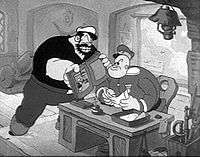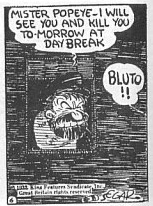Bluto
| Bluto | |
|---|---|
| Popeye character | |
 Bluto (left) in I'm in the Army Now (1936) | |
| Created by | E. C. Segar |
| Portrayed by | Paul L. Smith (1980 film) |
| Voiced by |
William Pennell (1933–1935,1942,1943) Gus Wickie (1935–1938) Pinto Colvig (1939–1940) Dave Barry (1942–1944) Tedd Pierce (1942) Jackson Beck (1944–1960s) Allan Melvin (1978–1988) Keith Scott (Popeye and Bluto's Bilge-Rat Barges)[1] Garry Chalk (Popeye's Voyage: The Quest for Pappy) |
| Information | |
| Gender | Male |
| Occupation | Sailor |
Bluto is a cartoon and comics character created in 1932 by Elzie Crisler Segar as a one-time character, named "Bluto the Terrible", in his Thimble Theatre comic strip (later renamed Popeye). Bluto made his first appearance September 12 of that year. Fleischer Studios adapted him the next year (1933) to be the main antagonist of their theatrical Popeye animated cartoon series.
Character
Bluto is a large, bearded, muscle-bound fellow who serves as Popeye's nemesis and arch-rival for the love of Olive Oyl. He mostly uses his physical brawn to accomplish what he is trying to do, but does display some ability for tactical planning. His voice is very loud, harsh and deep, with an incomprehensible bear-like growl between words and sentences. This voice, as well as the dark beard, crooked teeth, and bulk, were remarkably like that of the well-known at the time villain Red Flack in the 1930 film The Big Trail, played by Tyrone Power Sr.
Bluto, like Popeye, is attracted to Olive Oyl, and often attempts to kidnap her. However, with the help of some spinach, Popeye usually ends up defeating him. Some cartoons portray Popeye and Bluto as friends and Navy buddies, although Bluto usually turns on Popeye when an object of interest (usually Olive) is put between them. A prime example of this is the 1944 cartoon We're On Our Way to Rio. In the episode It's the Natural Thing to Do, however, Bluto is revealed out-of-character as living with Popeye and Olive as housemates, and simply enjoying fights together with Popeye in their free time when not appearing together in episodes.
There are considerable inconsistencies with regard to Bluto's strength. In some episodes he is weaker than Popeye, usually resorting to underhanded trickery to win. Other times Popeye stands no chance until he eats his spinach. In yet other cartoons the two characters are evenly matched with Bluto eventually winning before Popeye eats his spinach, as in the 1934 short, We Aim to Please. In some shorts Bluto is a match for Popeye even after he has eaten his spinach, as in 1935's Pleased to Meet Cha. Bluto is often portrayed as having a glass jaw. He has, on occasion, been knocked out by Olive Oyl and even by Popeye's infant ward Swee'Pea.

Bluto is generally portrayed as of low intelligence, typically acting without thinking and utilizing brute force, which often signals his defeat at the hands of Popeye. On rare occasions Bluto tries to sabotage Popeye before confronting him, such as when he tried to thwart a foreseeable fight by using a forklift to steal Popeye's store of spinach cans, disposing of them in a garbage dump.
In most cases, the name "Bluto" is used as a first name. In cartoons where Bluto portrays alternate characters, or "roles," the name can be used as a surname, as with lumberjack "Pierre Bluto" in the cartoon Axe Me Another and etiquette teacher "Professor Bluteau" in Learn Polikeness.[2]
Bluto vs. Brutus
After the theatrical Popeye cartoon series ceased production in 1957, Bluto's name was changed to Brutus because it was incorrectly believed that Paramount Pictures, distributors of the Fleischer Studios (later Famous Studios) cartoons, owned the rights to the name "Bluto". King Features actually owned the name, as Bluto had been originally created for the comic strip. Due to a lack of thorough research, they failed to realize this and reinvented him as Brutus to avoid supposed copyright problems.[3] "Brutus" (often pronounced "Brutusk" by Popeye) appears in the 1960–1962 Popeye the Sailor television cartoons, with his physical appearance changed, making him morbidly obese rather than muscular. He normally sported a blue shirt and brown pants, and didn't appear to wear any socks. The character reverted to Bluto for Hanna-Barbera's The All-New Popeye Hour, the 1980 live-action Popeye movie, as well as the 1987 Popeye and Son series also by Hanna-Barbera. The character was also named Bluto in the 2004 movie Popeye's Voyage: The Quest for Pappy. Brutus later appeared in the Popeye arcade game released by Nintendo.
Prior to the name change to Brutus, the bearded strongman was called or referred to as "The Big Guy That Hates Popeye", "A Big Brute", "Mean Man", and The Sea Hag's "Sonny Boy". The name "Brutus" was first used on Popeye-related products in 1960 and in print by 1962. In the comic book series, the name "Brutus" debuted in Popeye #64 (1962) but "Sonny Boy" again was used in issue 66 (1962). For issue 67 (1963) the name "Brutus" stuck with the character. September 30, 1962 appears to be the first Sunday page using the name "Brutus". In the daily strip Olive Oyl first called The Sea Hag's son "Brutus" on January 29, 1963. Once Brutus became a regular in the comic strip he was no longer related to the Sea Hag.[4] During the run of Charlton Comics' Popeye series, Brutus again became the son of the Sea Hag. For two cartoons in 1963 he was called "Pleeto".
It is generally accepted that Bluto and Brutus are one and the same. However, a 1988 Popeye comic book, published by Ocean Comics, presented the two characters as twin brothers.[5] In 1991 Bobby London, who wrote and drew the Popeye daily strip for six years, created the "Return of Bluto" story where the 1932 version of Bluto returns and discovers a number of fat, bearded bullies have taken his place, calling themselves "Brutus" (each one being a different version of Popeye's rival). On December 28, 2008 and April 5, 2009, the Popeye comic strip added Bluto in the capacity of twin brother of Brutus.[6][7]
In all Spanish-speaking countries, in Brazil and in the Philippines, the character is mostly known as "Brutus". His name, in Italian, has been translated as "Bruto" or, occasionally, as "Timoteo" (Timothy). In French, it has also been translated alternatively as "Brutus" or "Timothée".
Voicing
In the Paramount theatrical cartoons, Bluto was voiced by a number of actors, including William Pennell, Gus Wickie, Pinto Colvig, Dave Barry, Tedd Pierce and, Jackson Beck, who took over the role in 1944.[2] Beck also supplied the voice for Brutus in the early 1960s. In the 1980 live-action movie, he was portrayed by Paul L. Smith. In The All-New Popeye Hour and Popeye and Son, he was voiced by Allan Melvin. In Popeye's Voyage: The Quest for Pappy, he was voiced by Garry Chalk.
Other characters
In the animated cartoons, Popeye's foe is almost always Bluto, functioning in some capacity—fellow sailor, generic thug, carnival hypnotist, sheik, lecherous instructor, etc. However, in the Famous era shorts there have also been "original" one-time characters with Bluto-like personalities and mannerisms such as the blond, beardless lifeguard in "Beach Peach". Jackson Beck voiced these characters using the same voice.
See also

References
Notes
- ↑ Scott, Keith. "Popeye's Bilge-Rat Barges".
- 1 2 Grandinetti, Fred (2004). Popeye: an illustrated cultural history. McFarland. ISBN 0-7864-1605-X.
- ↑ Ian. "Straightdope.com". Straightdope.com. Retrieved July 14, 2009.
- ↑ Animated Views: Fifty Years of Brutus, October 25, 2010
- ↑ Fortier, Ron (w), Dunn, Ben; Grummett, Tom, Kato, Gary (p), Barras, Dell (i). "Double Trouble Down Under" Popeye Special 2 (September 1988), Ocean Comics
- ↑ December 28, 2008 Popeye Cartoon; retrieved July 14, 2009.
- ↑ April 5, 2009 Popeye Cartoon; retrieved July 14, 2009.
External links